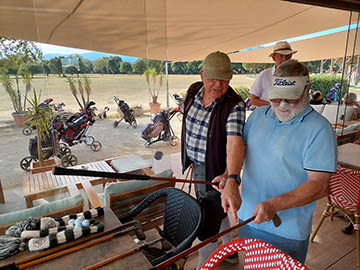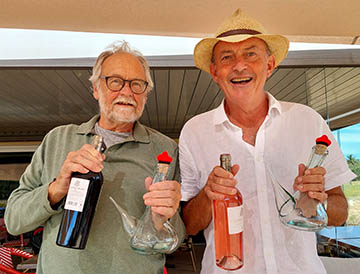By RICK ADAMS
How do you shift someone from ‘I enjoy playing golf’ to ‘I love hickory golf’?
It starts with putting a hickory club in their hands.
I had the pleasure this week of introducing several avid golfers to hickory. They’re among a group of friends with whom I play often when we are in the far south of France, near the Spanish border.
They are the U3A golf group, aka University of the 3rd Age, aka seasoned citizens, who play regularly, some twice or more each week, at Montescot, Falgos in the Pyrenees, and at clubs over the border in the Catalonia (Barcelona) region of Spain. Many of the U3A members are native Scots, Brits, Irish, Danes, Swedes, Belgians, and Germans, as well as French.
As U3A golf captain Simon Bridges puts it, ‘We are a group of friends who like to play golf.’ The friendship and camaraderie always come first.
They are well aware, of course, of my passion for hickory, as I often use my hickory clubs when I join their outings. Oftentimes, someone will ask to try a shot or two with one of my hickories.
We’ve talked about a hickory event for some time now, but the first attempt was thwarted by Covid.
Finally we scheduled the first “Sud de France” hickory championship for 19 September, only to have Queen Elizabeth’s funeral be scheduled on that day, so we deferred to 3 October at Montescot Golf Club near Perpignan.
Montescot is a 9-hole layout, not old by any means, but it’s where U3A plays every Monday, it’s flat, and the owners are very pleasant people. Right now they’re struggling to keep the course in shape despite the severe drought in the region (think Scottish bump-and-run). Oh, and it has a great view of Canigou, the sacred mountain in the area.
The round was preceded by a brief tutorial on the different types of hickory clubs on hand: pre-1935 ‘originals’ (Tom Stewart irons, Walter Hagen woods) as well as ‘replicas (JBL Golf irons and woods and a Tad Moore sand iron). Players were encouraged to use both types of clubs during the round. The format had each group sharing a playset, and there was much discussion of terms such as mashie and niblick and the approximate distances each club would carry.
Also discussed were hickory golf groups around the world and traditions such as vintage clothing.
The players took to the hickories with enthusiasm. Trevor King was ready to take the JBL putter home with him after rolling in long putts on the first two holes. Mike Dawson was hitting the driver so well he remarked he might just buy his own.
Players commented on the weight of the hickory clubs compared to modern metals. Another noticed the thickness of the grips. Another mentioned how the edge of the niblick blade dug into the turf.
There was only one club broken … and I was the one who did it. Cracked the shaft of my Stewart driving iron on the last hole (and it was the best shot I hit all day)! Good opportunity to start learning how to repair, reshaft and regrip my own clubs.
In keeping with the spirit of The Open Championship and the Claret Jug, the prize for the Sud de France event was a ‘Claret Porron,’ a traditional Catalan drinking pitcher, along with a bottle of local Bordeaux wine. The Languedoc-Roussillon region claims to be the largest contiguous vineyard in the world. ‘Sud de France’ is an umbrella brand name created in 2006 by the Languedoc-Roussillon region.
I don’t know if any of them will get hooked on hickory as I did, but they were certainly agreed that we should do it again. This is how interest in hickory golf spreads – friend to friend, sharing the fun.

Kevin Burton (left) and Jim Edwards compare ‘original’ and ‘replica’ hickory clubs prior to the 1st Sud de France Hickory Golf Championship.

The winners of the Claret Porrons in the 1st Sud de France hickory event were Phil Higgs for low gross (right) and Mike Dawson for low net.
